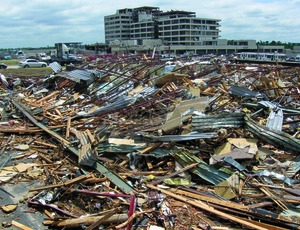As they sift through debris from one of the deadliest tornadoes in U.S. history, designers, builders and inspectors in Joplin, Mo., are evaluating the condition of the structures that survived the May 22 disaster and learning more about those that did not.

The Reston, Va.-based American Society of Civil Engineers sent a technical assessment team to Joplin to evaluate the extent of the damage and determine whether modifications to ASCE standards are warranted.
ASCE also plans to draft code recommendations based on its findings in Joplin and Tuscaloosa, Ala., the site of another deadly tornado in April. “Though they address hurricanes and earthquakes, major code groups don't address tornadoes,” says ASCE member John van de Lindt, a professor with the University of Alabama's department of civil, construction and environmental engineering in Tuscaloosa. “The problem is that tornadoes are unique because they not only subject buildings to the twisting loads associated with earthquakes but uplift loads as well.”
In combination with record winds, the two forces proved deadly in Joplin, a city of 50,000. With area homes and businesses designed to withstand 90-mph gusts, many proved no match for the tornado's 200-mph winds. The EF5 twister cut a mile-wide swath across a six-mile stretch of the city.
In addition to nearly 8,000 homes, the tornado damaged or destroyed hundreds of non-residential buildings, including Joplin High School, St. John's Regional Medical Center and several big-box stores, including Home Depot, Lowe's and Walmart. More than 150 residents died, and another 1,000 were injured.
In mid-June, members of regional and national American Institute of Architects chapters met in Joplin to start planning sessions among designers, builders, engineers, city officials and Federal Emergency Management Agency staff.
“The plan is to send a design assistance team to Joplin later this summer to facilitate a process that helps the city build back better and stronger,” says Erica Gees, executive director with AIA Legacy, Washington, D.C. “We're working in partnership with AIA national and state and local chapters … in full coordination with the city and FEMA.”
In the meantime, the city has placed a hold on building permits in order to meet an Aug. 7 deadline for debris removal, a federal requirement for a 90% funding reimbursement share.
Government contractors arrived on June 17 to begin expedited debris removal under the direction of the U.S. Army Corps of Engineers. The Corps is focusing on residential neighborhoods, where front-end loaders and backhoes are loading debris into large dump trucks.
Non-residential structural damage was worst among single-story buildings that employed roof decks as diaphragms, says Robert Treece, vice president with structural engineer Thornton Tomasetti, Kansas City, Mo. “Once flying debris destroyed windows, a combination of an increase in internal pressure and uplift pressure from external winds caused decks to blow off. After that, walls and supporting structure collapsed,” says Treece, who evaluated more than 20 medical office and outpatient treatment centers to expedite insurance claims.

Post a comment to this article
Report Abusive Comment